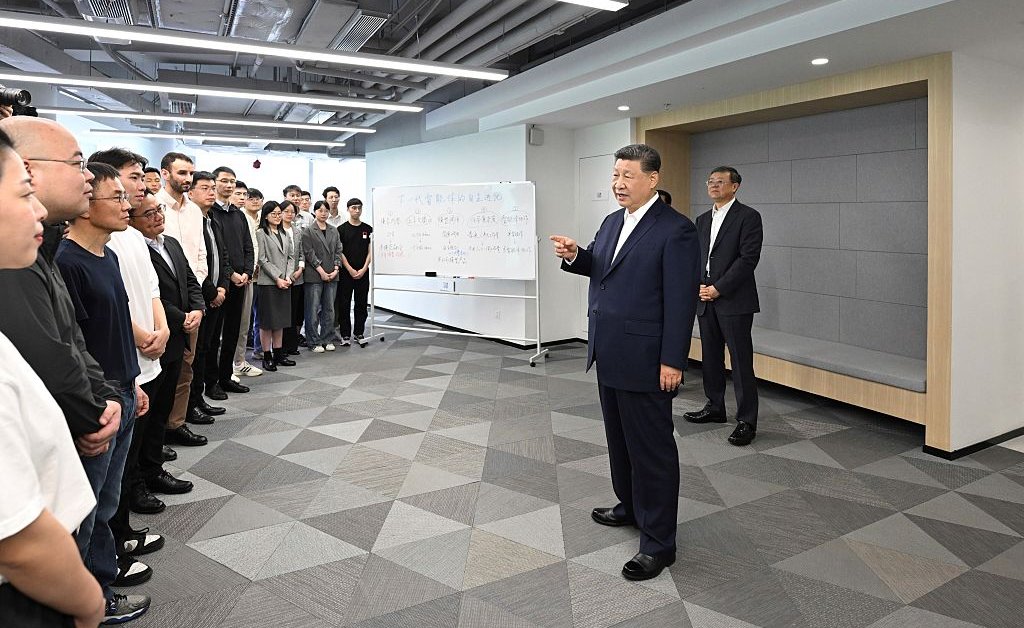“China doesn’t care about AI safety—so why should we?” This flawed logic pervades U.S. policy and tech circles, offering cover for a reckless race to the bottom as Washington rushes to outpace Beijing in AI development.
According to this rationale, regulating AI would risk falling behind in the so-called “AI arms race.” And since China supposedly doesn’t prioritize safety, racing ahead—even recklessly—is the safer long-term bet. This narrative is not just wrong; it’s dangerous.
Ironically, Chinese leaders may have a lesson for the U.S.’s AI boosters: true speed requires control. As China’s top tech official, Ding Xuexiang, put it bluntly at Davos in January 2025: “If the braking system isn’t under control, you can’t step on the accelerator with confidence.” For Chinese leaders, safety isn’t a constraint; it’s a prerequisite.
AI safety has become a political priority in China. In April, President Xi Jinping chaired a rare Politburo study session on AI warning of “unprecedented” risks. China’s National Emergency Response Plan now lists AI safety alongside pandemics and cyberattacks. Regulators require pre-deployment safety assessments for generative AI and recently removed over 3,500 non-compliant AI products from the market. In just the first half of this year, China has issued more national AI standards than in the previous three years combined. Meanwhile, the volume of technical papers focused on frontier AI safety has more than doubled over the past year in China.
But the last time U.S. and Chinese leaders met to discuss AI’s risks was in May 2024. In September, officials from both nations hinted at a second round of conversations “at an appropriate time.” But no meeting took place under the Biden Administration, and there is even greater uncertainty over whether the Trump Administration will pick up the baton. This is a missed opportunity.
Read More: The Politics, and Geopolitics, of Artificial Intelligence
China is open to collaboration. In May 2025, it launched a bilateral AI dialogue with the United Kingdom. Esteemed Chinese scientists have contributed to major international efforts, such as the International AI Safety Report backed by 33 countries and intergovernmental organisations (including the U.S. and China) and The Singapore Consensus on Global AI Safety Research Priorities.
A necessary first step is to revive the dormant U.S.–China dialogue on AI risks. Without a functioning government-to-government channel, prospects for coordination remain slim. China indicated it was open to continuing the conversation at the end of the Biden Administration. It already yielded a modest but symbolically important agreement: both sides affirmed that human decision-making must remain in control of nuclear weapons. This channel has potential for further progress.
Going forward, discussions should focus on shared, high-stakes threats. Consider OpenAI’s recent classification of its latest ChatGPT Agent as having crossed the “High Capability” threshold in the biological domain under the company’s own Preparedness Framework. This means the agent could, at least in principle, provide users with meaningful guidance that might facilitate the creation of dangerous biological threats. Both Washington and Beijing have a vital interest in preventing non-state actors from weaponizing such tools. An AI-assisted biological attack would not respect national borders. In addition, leading experts and Turing Award winners from the West and China share concerns that advanced general-purpose AI systems may come to operate outside of human control, posing catastrophic and existential risks.
Both governments have already acknowledged some of these risks. President Trump’s AI Action Plan warns that AI may “pose novel national security risks in the near future,” specifically in cybersecurity and in chemical, biological, radiological, and nuclear (CBRN) domains. Similarly, in September last year, China’s primary AI security standards body highlighted the need for AI safety standards addressing cybersecurity, CBRN, and loss of control risks.
From there, the two sides could take practical steps to build technical trust between leading standards organizations—such as China’s National Information Security Standardization Technical Committee (TC260) and the America’s National Institute of Standards and Technology (NIST)
Plus, industry authorities, such as the AI Industry Alliance of China (AIIA) and the Frontier Model Forum in the US, could share best practices on risk management frameworks. AIIA has formulated “Safety Commitments” which most leading Chinese developers have signed. A new Chinese risk management framework, focused fully on frontier risks including cyber misuse, biological misuse, large-scale persuasion and manipulation, and loss of control scenarios, was published during the World AI Conference (WAIC) and can help both countries align.
Read More: The U.S. Can’t Afford to Lose the Biotech Race with China
As trust deepens, governments and leading labs could begin sharing safety evaluation methods and results for the most advanced models. The Global AI Governance Action Plan, unveiled at WAIC, explicitly calls for the creation of “mutually recognized safety evaluation platforms.” As an Anthropic co-founder said, a recent Chinese AI safety evaluation report has similar findings with the West: frontier AI systems pose some non-trivial CBRN risks, and are beginning to show early warning signs of autonomous self-replication and deception. A shared understanding of model vulnerabilities—and of how those vulnerabilities are being tested—would lay the groundwork for broader safety cooperation.
Finally, the two sides could establish incident-reporting channels and emergency response protocols. In the event of an AI-related accident or misuse, rapid and transparent communication will be essential. A modern equivalent to “hotlines” between top AI officials in both countries could ensure real-time alerts when models breach safety thresholds or behave unexpectedly. In April, President Xi Jinping explicitly stressed the need for “monitoring, early risk warning and emergency response” in AI. After any dangerous incident, there should be a pre-agreed upon plan for how to react.
Engagement won’t be easy—political and technical hurdles are inevitable. But AI risks are global—and so must be the governance response. Rather than using China as a justification for domestic inaction on AI regulation, American policymakers and industry leaders should engage directly. AI risks won’t wait.
